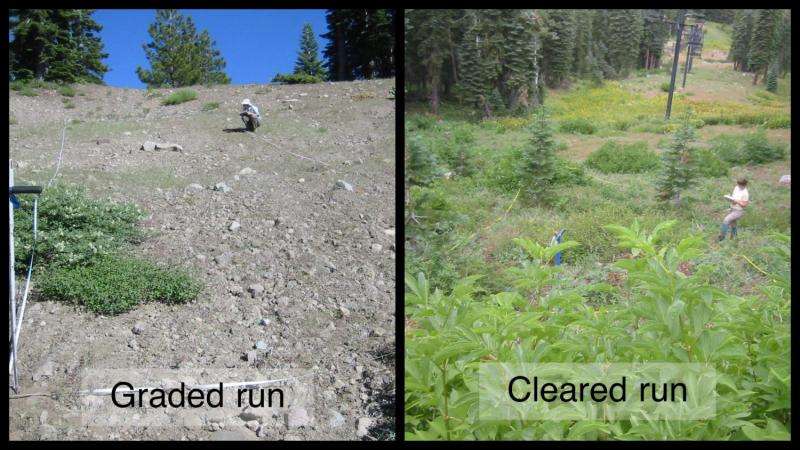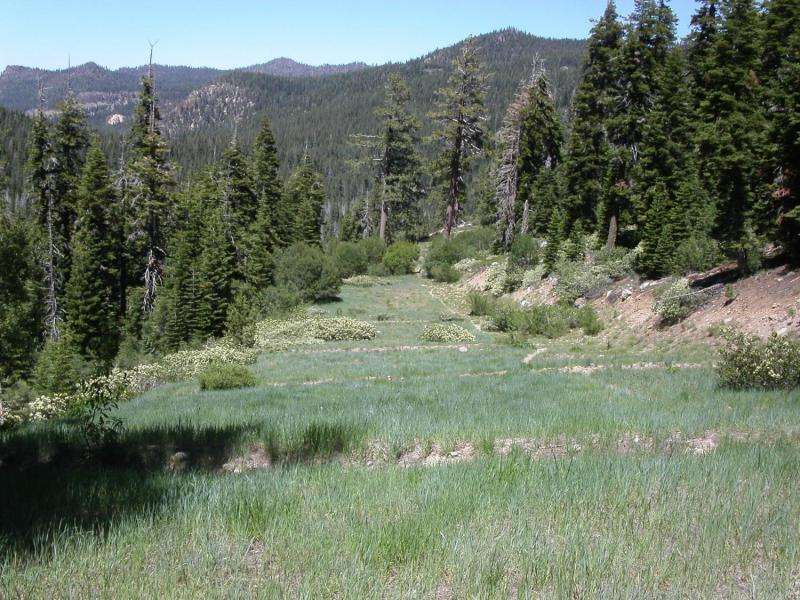Land recovery after a ski slope is abandoned can be starkly different depending on how it was constructed. The graded run, left, was abandoned 13 years before with little sign of new vegetation. The cleared run, right, was abandoned 10 years before and plant life is abundant. Credit: Andrew Burt/Jessica Hite
What happens to the land when a ski run is abandoned? Not much, if the run was previously graded, according to a study from the University of California, Davis.
The study, published online Dec. 16 in the Journal of Applied Ecology, evaluated six abandoned ski areas in the Northern Sierra region of California and Nevada. It found that runs that were graded showed no predictable recovery even 40 years after abandonment. With graded runs, heavy machinery is used to remove vegetation, boulders and, consequently, much of the topsoil and seed bank during construction.
In contrast, "cleared" runs, in which trees and shrubs were cut with their roots left in the ground, consistently recovered to blend in with the surrounding forest. Trees and other vegetation grew back over time, and bare ground and visible soil erosion decreased, protecting water quality.
With climate change, more abandonment likely
"As more ski areas become abandoned, there should be some effort taken to actively restore graded ski slopes," said lead author Jennifer Burt, a UC Davis doctoral student at the time of the study and currently a restoration ecologist at AECOM Environment in Sacramento. "These are large land areas in some cases and, as we're seeing, they don't recover on their own."
The sites ranged from 10 to 43 years since abandonment and, like many ski areas in the western U.S., most had operated under special use permit on USDA Forest Service lands. The study included the Lake Tahoe area sites of Powder Bowl, Plavada, Tannenbaum, Edelweiss, Iron Mountain and Echo Summit.
This graded ski run at Powder Bowl ski area in the Sierra Nevada mountains was abandoned 22 years prior, with little plant regrowth. Credit: Jennifer Burt
"We're in this time of visible climate change," said co-author Jeffrey Clary, reserve manager of Stebbins Cold Canyon Reserve in the UC Davis Natural Reserve System. "Land uses we once thought were permanent, we're now seeing are likely not. As a land manager, to me, it only makes sense to look at a longer-term picture."
Not 'moonscapes,' but stunted recovery
Abandoned graded runs aren't all "moonscapes," Burt said. Aside from some barren patches, the graded lands she studied typically did regrow some trees and other plant life over time. But with a shallower soil depth, the vegetation there was stunted, less robust and less diverse. The growth there was unpredictable, and the land showed visible signs of erosion compared with formerly cleared runs.
Clearing is the first step in creating any ski run, Burt said. Grading is a second step taken to further smooth the slope, and it is widely practiced in the ski industry.
Grading requires more upfront costs than simply clearing the run. The process also scrapes and compacts the soil, reducing the ability of water to permeate the soil, so ongoing erosion repair is an additional need.
So why do ski areas grade runs at all? It can allow them to open ski runs up to two weeks earlier in the season. Cleared runs need roughly an additional one to two feet of snow before opening to skiers.
A failing grade
Burt published a related study in 2009 that looked at the negative effects of grading on active, not abandoned, ski slopes.
Both studies have clear implications for land management, including pointing out more desirable methods for constructing ski slopes, and the need for active restoration of abandoned graded ski slopes.
"If you're going to create a new ski slope, ideally, you shouldn't grade it," Burt advised. "If grading is necessary, use a light touch and grade as little of the slope as possible so you don't destroy the soil function for the long haul."
More information: Jennifer W. Burt et al. Initial disturbance intensity affects recovery rates and successional divergence on abandoned ski slopes, Journal of Applied Ecology (2015). DOI: 10.1111/1365-2664.12584
Journal information: Journal of Applied Ecology
Provided by UC Davis






















